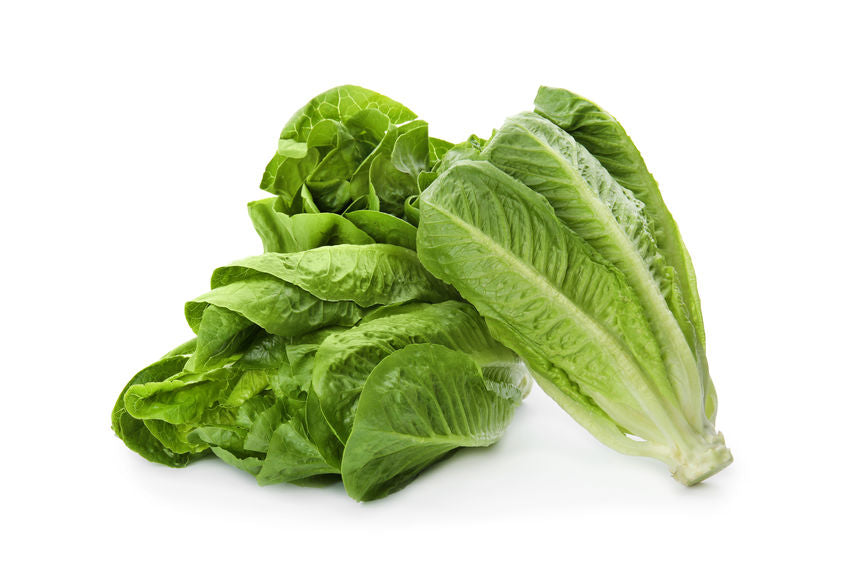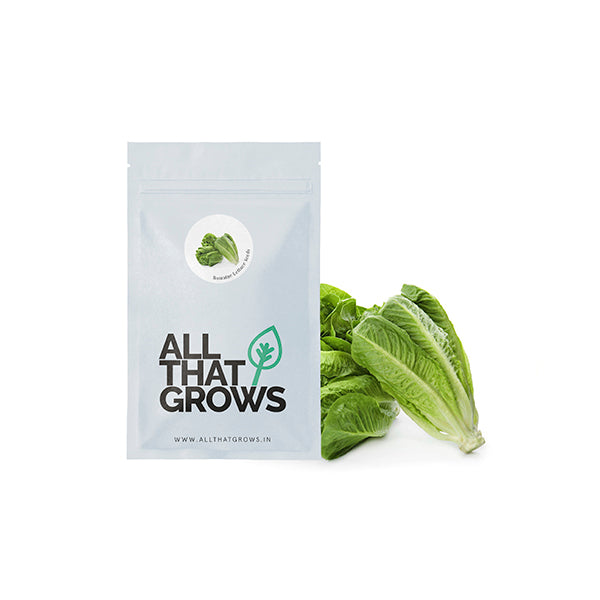



- SOWING
TIMEAugust to October
- Sowing
DistanceLine to Line - 10 to 12 inches
- Fruit
WeightN/A
- Fruit
ShapeN/A
- Days to
maturity75 to 85 days
- Details
- How to sow
- Reviews
Botanically known as Lactuca Sativa, Romaine Lettuce is believed to be one of the oldest varieties of Lettuce. Romaine lettuce is said to have been in use as early as 55 B.C, being served in spreads for Persian Kings for their culinary and medicinal values. Romaine lettuce is also known as Cos Lettuce. With their elongated shape, Romaine lettuce heads can grow up to 4 to 6 inches long with upright leaves. The outer leaves of romaine lettuce are dark green with noticeably lighter green around the central part. The mild and crunchy taste of this variety of lettuce is perfect for tossed salads, sandwiches if you want that extra crisp. Romaine lettuce can also withstand heat which makes it fit for boiling, braising with other vegetables. On the nutritional profile, this green also ranks higher being an excellent source of vitamins A, C, and K, dietary fibers, potassium, iron, and folate. The leaves of romaine lettuce remain fresh for a week if you keep the moisture in check stored in a refrigerator.
Planting instructions
To promote good germination for your romaine lettuce, prepare the sowing bed by tilling well before sowing the seeds. The soil on your seedbed must be loose and well-draining and not too soggy. Directly sowing the seeds in the soil about half an inch deep and cover them with ¼ to ½ inches of soil. You also plant chives or garlic as companion plants for romaine lettuce to keep the pests at bay. Make sure that the soil remains moist but well-drained or root rot & bolting may damage your plants.
Growing Requirements
pests
Aphids are the most common pests that are likely to damage the romaine lettuce. They can suck the water and nutrients away from the lettuce leaves and cause them to wilt. This can also cause the plant to have molding issues. Organic neem spray or oil is your best bet against aphids. Moreover snails, slugs and caterpillars can also damage your lettuce plant and timely removing them from the plant is the most effective way to protect your plant.
soil
Ensure fertile, well-drained, moist soil for lettuce with a pH between 6.0 and 7.0. The romaine lettuce grows best in loose soil. Lettuce is sensitive to acidic soil so maintain a pH above 6.
spot
Romaine lettuce grows best in full sun but can also tolerate partial shade as well.
temperature
Ideal soil temperature for germination: 10-22°C (50-72°F). If the weather is too hot, the plant may go straight to seeding instead of producing optimum leaves.
watering
Water the lettuce plant lightly and frequently to keep the soil moist to promote leaf growth instead of root growth.
how to harvest
Start harvesting romaine lettuce from outside of the lettuce head, leaving the central bud to grow more leaves. Harvesting lettuce leaves in the morning will give you the best flavor. Too mature lettuce leaves may go bitter or woody in taste, so keep a check on your lettuce bed every day to harvest ready-to-use leaves on time. Keep the lettuce in a covered in a paper towel in the crisper section of the refrigerator to keep them fresh for 7 to 10 days after harvesting.

Customer Reviews
The productiveness of any seed we sell is subject to your local climatic conditions*, the sowing method you adopt, and your commitment to the planting process. We give no warranty, expressed or implied, and are in no way responsible for the produce.
Please note that all our seasonal recommendations/ sowing information is as per the local climatic conditions. *For more information on the optimum conditions required for growing seeds in your region, please contact us at, hello@allthatgrows.in or Whatsapp us at, +91 8544865077
Questions & Answers
Have a Question?
Be the first to ask a question about this.




Romaine Lettuce Seeds
Seed Type : Non-Hybrid, Open Pollinated and Non-GMO
Maturity : Late
Head Type : Loose Leaves And Small
Leaf Colour : Green
Grow this with
Botanically known as Lactuca Sativa, Romaine Lettuce is believed to be one of the oldest varieties of Lettuce. Romaine lettuce is said to have been in use as early as 55 B.C, being served in spreads for Persian Kings for their culinary and medicinal values. Romaine lettuce is also known as Cos Lettuce. With their elongated shape, Romaine lettuce heads can grow up to 4 to 6 inches long with upright leaves. The outer leaves of romaine lettuce are dark green with noticeably lighter green around the central part. The mild and crunchy taste of this variety of lettuce is perfect for tossed salads, sandwiches if you want that extra crisp. Romaine lettuce can also withstand heat which makes it fit for boiling, braising with other vegetables. On the nutritional profile, this green also ranks higher being an excellent source of vitamins A, C, and K, dietary fibers, potassium, iron, and folate. The leaves of romaine lettuce remain fresh for a week if you keep the moisture in check stored in a refrigerator.
Seed Type : Non-Hybrid, Open Pollinated and Non-GMO
Maturity : Late
Head Type : Loose Leaves And Small
Leaf Colour : Green
- SOWING
TIMEAugust to October
- Sowing
DistanceLine to Line - 10 to 12 inches
- Fruit
WeightN/A
- Fruit
ShapeN/A
- Days to
maturity75 to 85 days
Planting instructions
To promote good germination for your romaine lettuce, prepare the sowing bed by tilling well before sowing the seeds. The soil on your seedbed must be loose and well-draining and not too soggy. Directly sowing the seeds in the soil about half an inch deep and cover them with ¼ to ½ inches of soil. You also plant chives or garlic as companion plants for romaine lettuce to keep the pests at bay. Make sure that the soil remains moist but well-drained or root rot & bolting may damage your plants.
Growing Requirements
pests
Aphids are the most common pests that are likely to damage the romaine lettuce. They can suck the water and nutrients away from the lettuce leaves and cause them to wilt. This can also cause the plant to have molding issues. Organic neem spray or oil is your best bet against aphids. Moreover snails, slugs and caterpillars can also damage your lettuce plant and timely removing them from the plant is the most effective way to protect your plant.
soil
Ensure fertile, well-drained, moist soil for lettuce with a pH between 6.0 and 7.0. The romaine lettuce grows best in loose soil. Lettuce is sensitive to acidic soil so maintain a pH above 6.
spot
Romaine lettuce grows best in full sun but can also tolerate partial shade as well.
temperature
Ideal soil temperature for germination: 10-22°C (50-72°F). If the weather is too hot, the plant may go straight to seeding instead of producing optimum leaves.
watering
Water the lettuce plant lightly and frequently to keep the soil moist to promote leaf growth instead of root growth.
how to harvest
Start harvesting romaine lettuce from outside of the lettuce head, leaving the central bud to grow more leaves. Harvesting lettuce leaves in the morning will give you the best flavor. Too mature lettuce leaves may go bitter or woody in taste, so keep a check on your lettuce bed every day to harvest ready-to-use leaves on time. Keep the lettuce in a covered in a paper towel in the crisper section of the refrigerator to keep them fresh for 7 to 10 days after harvesting.



 Sign In
Sign In








